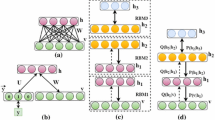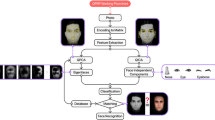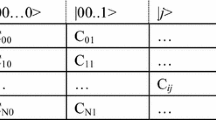Abstract
Gabor wavelet is considered the best mathematical descriptor for receptive fields in the striate cortex. Besides, as a basis function, it is suitable to sparsely represent natural scenes due to its property in maximizing information. It is argued that Gabor-like receptive fields are emerged by sparseness-enforcing or infomax method. In this paper, we incorporate Gabor overcomplete representation into quantum holography for image recognition tasks, with suggestions in improvements through iterative method for reconstruction.









Similar content being viewed by others
References
Bastiaans M. Gabor’s expansion of a signal into gaussian elementary signals. Proc IEEE. 1980;68:538–9.
Bell A, Sejnowski T. An information-maximization approach to blind separation and blind deconvolution. Neural Comput. 1995;7:1129–59.
Bell A, Sejnowski T. The “independent components” of natural scenes are edge filters. Vision Res. 1997;37:3327–38.
Buser P, Imbert M. Vision. Cambridge, MA: MIT Press; 1992.
Daugman J. Complete discrete 2-D gabor transforms by neural networks for image analysis and compression. IEEE Trans Acoust. 1988;36:1169–79.
Field DJ. Scale-invariance and self-similar ‘wavelet’ transforms: an analysis of natural scenes and mammalian visual systems. In: Wavelets, fractals and fourier transforms: new development and new applications. Oxford: Oxford University Press; 1993.
Grossmann A, Kronland-Martinet R, Morlet J. Reading and understanding continuous wavelet transforms. In: Combes JM, Grossman A, Tchamitchian P, editors. Wavelets. Berlin: Springer; 1989. p. 2–20.
Hubel D, Wiesel T. Receptive fields, binocular interaction, and functional architecture in the cat’s visual cortex. J Physiol (Lond). 1962;160:106–54.
Jones J, Palmer L. An evaluation of the two-dimensional gabor filter model of simple receptive fields in cat striate cortex. J Neurophysiol. 1987;58:1233–58.
Kyrki V, Kamarainen JK. Kälviäinen.: simple Gabor feature space for invariant object recognition. Pattern Recognit Lett. 2004;25:311–8.
Lee T. Image representation using 2D Gabor wavelets. IEEE Trans Pattern Anal Mach Intell. 1996;18(10):1–13.
Linsker R. Self-organization in a perceptual network. Computer. 1988;21(3):105–17.
Marcelja S. Mathematical description of the responses of simple cortical cells. J Opt Soc Am. 1980;70:1297–300.
Okajima K. The Gabor function extracts the maximum information from input local signals. Neural Netw. 1998;11:435–9.
Olshausen B, Field D. Emergence of simple-cell receptive field properties by learning a sparse code for natural images. Nat Lett. 1996;381:607–9.
Olshausen B, Field D. Sparse coding with an overcomplete basis set: a strategy employed by V1? Vision Res. 1997;37:3311–25.
Palmer S. Vision science (photons to phenomenology). Cambridge, MA: MIT Press; 1999.
Peruš M. A synthesis of the Pribram Holonomic theory of vision with quantum associative nets after pre-processing using ICA and other computational models. Int J Comput Anticipatory Syst. 2001;10:352–67.
Peruš M. Multi-level synergetic computation in brain. Non-linear phenom. Complex Syst. 2001;4:157–93.
Peruš M, Bischof H, Caulfield HJ, Loo CK. Quantum-implementable selective reconstruction of high-resolution images. Appl Opt. 2004;43(33):6134–8.
Peruš M, Bischof H, Loo CK. Bio-computational model of object-recognition: quantum Hebbian processing with neurally shaped Gabor wavelets. Biosystems. 2005;82:116–26.
Pollen D, Ronner S. Phase relationships between adjacent simple cells in the visual cortex. Science. 1981;212:1409–11.
Pribram KH. Brain and perception (holonomy and structure in figural processing). Hillsdale, NJ: Lawrence Erlbaum Associates; 1991.
Author information
Authors and Affiliations
Corresponding author
Rights and permissions
About this article
Cite this article
Tay, N.W., Loo, C.K. & Peruš, M. Face Recognition with Quantum Associative Networks Using Overcomplete Gabor Wavelet. Cogn Comput 2, 297–302 (2010). https://doi.org/10.1007/s12559-010-9047-2
Received:
Accepted:
Published:
Issue Date:
DOI: https://doi.org/10.1007/s12559-010-9047-2




